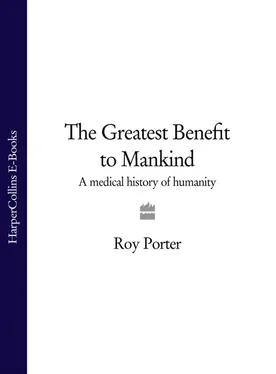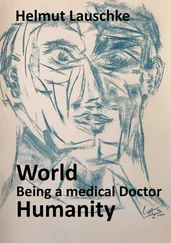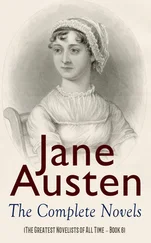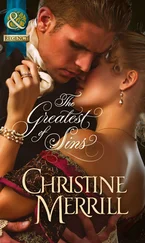As the entrepôt of the Mediterranean, enjoying close links with the Middle East and the overland spice trade from the Indies, Venice was the natural centre for the humanist goal of recovering classical medicaments. Not least, the Venetian Republic controlled Crete and Cyprus, the herb gardens of the ancients. Drugs unknown to the latin West – balsam and myrrh for instance – were rediscovered. Famous for its purging powers, rhubarb had entered Europe through the overland trade routes from the East; by the early seventeenth century, seeds from Bulgaria allowed one medically valuable type of rhubarb (Rhaponticum, from the Pontus or Black Sea) to be grown in Europe, while search continued for the ‘true’ rhubarb which Marco Polo had reported in 1295 as deriving from China. Theriac, that panacea of the ancients, composed of up to a hundred herbal, animal and mineral ingredients, seemed in the 1540s quite impossible to compound; many of its ingredients were unknown and more than twenty substitutes were needed. But by 1566 the Veronese botanist-pharmacist Francesco Calzolari (1522–1609) was using only three proxies. Physicians grew confident that the remedies of the ancients had been recovered.
Thanks to Iberian voyages of discovery, new drugs filtered in, together with foodstuffs like potatoes. Cocoa came back with Cortés in 1529, becoming a favourite drink, a specific for ‘wasting diseases’, a stimulant, and even the basis of cocoa-butter suppositories. Meanwhile the Portuguese had rounded the Cape of Good Hope in 1487–8 and reached India in 1499. By 1512–13 they landed in the legendary Spice Islands, the Moluccas, whose spices had traditionally arrived in Europe via the overland route.
Remedies from distant parts entered into scholarship, particularly through the writings of Nicolas Monardes (c. 1493–1588) and Garcia d’Orta (1501–68). Educated at Seville, Monardes commented that New World drugs were inferior to those of Spain (pharmaceutical chauvinism was strong), but he later changed his mind, enthusiastically praising their powers in his Dos Libros (1565–74). The book followed a standard format, giving for each plant its place of origin, appearance, colour, properties and uses. New World plants posed problems, for their virtues were uncertain. This led him to concentrate on the distinguishing marks of the new plants and to describe how they were processed by the American Indians. Together with coca, jalap, sarsaparilla and sassafras (these latter famed for blood-cleansing), one of his best-known descriptions was that of tobacco, which he praised for curing head pains, toothaches, bad breath, chilblains, worms, joint pains, swellings, poisoned wounds, kidney stones, carbuncles and fatigue. Its efficacy derived from its heating and drying qualities. Despite King James I’s strictures against ‘this filthy custom’, tobacco enjoyed a high medicinal reputation in the seventeenth century.
In the face of the terrifying syphilis epidemic, imported plant remedies might appear godsends, for treatment with mercury was almost worse than the disease. In the Caribbean the Spaniards saw syphilis (more probably yaws) treated by decoctions made from guaiac wood (Guaiacum officinalis) ; by 1508 this was being imported into Spain and its use became widespread. Also known as ‘holy wood’, guaiac was obtained from evergreens indigenous to the West Indies and South America. The folk belief that God planted cures where diseases arose reinforced the conjectural New World origin for syphilis. Shiploads of guaiac were imported into Europe, organized by the Fuggers of Augsburg, the mercantile and banking family who monopolized the trade and profited mightily. The German humanist and soldier Ulrich von Hutten (1488–1523) experienced the horrors of the mercury treatment; he went through eleven mercury cures in nine years, then he heard of guaiac, and after repeated infusions believed he was cured. Von Hutten’s De guaiaci medicina et morbo gallico (1519) [On the Guaiac Remedy and the French Disease] was translated into German and French, but by the time Monardes wrote in 1565 guaiac was losing support.
One key remedy from the East was opium, largely imported from Turkey. It had been in use in Egypt in the second millennium BC, and Avicenna called it ‘the most powerful of stupefacients’. Ever the queen of drugs, it was profusely used in western medicine from the sixteenth century, and Thomas Sydenham (1624–89) later proclaimed that ‘among the remedies which it has pleased the Almighty God to give to man to relieve his sufferings, none is so universal and so efficacious as opium.’ It seemed the wonder drug; not just a pain-deadener, it also stopped dysentery and relieved respiratory disorders.
India supplied new remedies. In 1563 Garcia D’Orta published Coloquios dos simples, e drogas he cousas mediçinais da India [Dialogues on Simples and Drugs and Medical Matters from India] which described such eastern products as aloes, camphor, sandalwood, ginger, asafoetida and betel, and new fruits such as mangoes. Like the Italian humanist botanists, he had to confront identification problems. (Was modern cinnamon the ‘canella’, ‘cinnamon’ or ‘cassia’ of the ancients?) Other eastern drugs filtered to the West later, including Chinese rhubarb and ginseng, introduced in the eighteenth century by the Jesuits.
Thanks in part to the labours of the botanists and the importation of new drugs, the apothecary’s trade boomed, though for many (witness Romeo’s remarks) the apothecary remained a wretch vending poisons:
I do remember an apothecary
And hereabouts he dwells – whom late I noted
In tatter’d weeds, with overwhelming brows,
Culling of simples; meagre were his looks,
Sharp misery had worn him to the bones;
And in his needy shop a tortoise hung,
An alligator stuff’d and other skins,
Of ill-shap’d fishes …
Like other branches of medicine, apothecaries organized themselves. In England, James I recognized them as a special body in the Grocers’ Company in 1607, and ten years later they gained their independence, organizing as the Masters, Wardens, and Society of the Art and Mystery of the Apothecaries of the City of London.
Renaissance humanism, mysticism, hermeticism and astrology fostered interest in the human soul, the spiritual fulcrum in a cosmos governed by supernatural forces – good and evil. It is not surprising, therefore, that one field in which Renaissance philosophy made a contribution to medicine was mental disorder. Theories remained complex, however. The neo-Platonist Ficino related melancholia to the sway of Saturn, but also to the action of black bile, the humour of genius and of depression.
Humanist moralists explored the mind, notably the French essayist, Michel de Montaigne (1533–92), twice mayor of Bordeaux. Suffering agony from a bladder stone * and sickened by religious and dynastic bloodshed, he retired from the world to compose his mind in tranquillity, only to find himself haunted by ‘monsters’ and ‘chimeras’. Solitude sparked ‘melancholy adust’, a sick humour disposing his melancholic temperament towards madness. Composing his Essais (1580) was an antidote, a writing cure aimed at restoring balance through anatomizing his mind in quest of self-knowledge.
Montaigne kept his soul ‘at home’ in the body, studying both, hoping to grasp how man should live wisely and face death well. Yet in response to the old Socratic injunction of self-knowledge (‘nosce te ipsum’), he was sceptical: Que sçay-je? (What do I know?), he asked. Such themes were relentlessly pursued, not least by Shakespeare, whose contemporary, Robert Burton (1557–1640), described himself as ‘fatally driven’ upon the rock of melancholy and mixed philosophy and medicine. His Anatomy of Melancholy (1621) was a satirical flagellation of folly but also a serious medical inquiry which included the following causes of depression: ‘idleness, solitariness, overmuch study, passions, perturbations, discontents, cares, miseries, vehement desires, ambitions’, and hundreds more.
Читать дальше












